

|
Soundclip:
|
| See Steve's Hand-Written Solo
Transcription |
|
Steve Khan's solo on: "Latin Genetics"(Ornette Coleman) Sometimes one can come to feel that they know a great deal about a favorite artist's body of work, and then, suddenly, that secure feeling can come crashing down around you. Such was the case not too long ago when I happened to be investigating some things at YouTube, and all of sudden, I heard the great Ornette Coleman Quartet playing a tune that I had never heard before, live in concert from Hamburg, Germany in 1987. 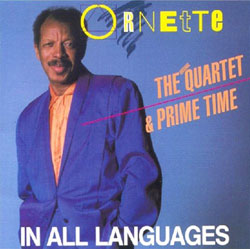 The tune absolutely knocked me out on countless levels, and, after searching around, I finally learned that it was titled, of all things, "Latin Genetics." Further research told me that it had been recorded in 1986 by my dear friend, Ed Rak at Clinton Studios in New York, and then, released in early 1987. As part of this double album package, Ornette had reunited the great quartet: Don Cherry; Charlie Haden; and Billy Higgins. How wonderful it was to hear them all together again. It sounded as though they had never stopped playing together. It was so refreshing to hear them playing their music again, and I made a mental note to myself that, IF I was ever going to record again, I would have to include this tune! The tune absolutely knocked me out on countless levels, and, after searching around, I finally learned that it was titled, of all things, "Latin Genetics." Further research told me that it had been recorded in 1986 by my dear friend, Ed Rak at Clinton Studios in New York, and then, released in early 1987. As part of this double album package, Ornette had reunited the great quartet: Don Cherry; Charlie Haden; and Billy Higgins. How wonderful it was to hear them all together again. It sounded as though they had never stopped playing together. It was so refreshing to hear them playing their music again, and I made a mental note to myself that, IF I was ever going to record again, I would have to include this tune!As time passed, and I had committed myself to going ahead and preparing to record "BACKLOG," I began to flesh out melodic and rhythmic concepts for all the tunes that I had selected. Part of that process for me is to then construct working demos using Pro Tools, and also employing Marc Quiñones' brilliant CD for LP(Latin Percussion) of Latin Percussion Samples, recorded in 1996. At the beginning of the CD, Marc plays 16 tracks of Afro-Caribbean rhythms, where he plays all the parts together, and then each individual percussion element is separated, and you can then use these wonderful groove samples to recreate them at your desired tempo. I have been using this CD as part of my own demo process for years now. In considering "Latin Genetics," I knew that I heard this tune being played to the Puerto Rican rhythms of plena. I've tried, in the past, to get Marc to do this on other tunes, but something always goes astray, and we end-up using a different rhythm, but this time, I was going to fight harder for what I wanted. Where plena is concerned, my model has always been the tune "Elena, Elena" by Manny Oquendo y Libre. I just love everything about that performance. So, I carefully investigated its tempo, and began prepare my demo accordingly. At some point, during the process of preparing to record such an album, I always try to have one face-to-face meeting around the computer with Marc, where we go through all the demos for all the tunes, look at the scores that I've compiled to that point. Once we are sitting together, the first order of business is that we make certain that I have not committed any heinous crimes against the clave. If he clears me on all my work in that area, we go on to other details. I was prepared for almost any kind of disagreement that we might have where plena was concerned, but I hadn't anticipated what he was actually going to say to me. He told me that we could do "Latin Genetics" as a plena but that the tempo that I had chosen was just too fast to make it groove properly. I didn't understand that at all, because the demo sounded great to me. I later came to understand that Marc was most concerned about the [B] section, because he felt that that section would feel better if the tune was slower. So, to honor his thought process, I began to revise my demo at his suggested tempo. But, the problem with that for me was that, at his suggested tempo, letter [A] began to feel like a funeral dirge more than any uptempo tune. 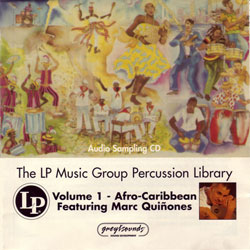 So, I began to try to bring the tempo back up to a compromise level. I went through almost every possibility, considering that this was in cut-time, and eventually, the best that I could do was coming in at 3 metronome markings below where I had originally started. Then I just hoped that Marc would let it go, and we could play the tune as I had envisioned it. Lucky for me, he gave me a break on this one, and believe me, I was really happy and relieved!!! You can now be the judge of the results. So, I began to try to bring the tempo back up to a compromise level. I went through almost every possibility, considering that this was in cut-time, and eventually, the best that I could do was coming in at 3 metronome markings below where I had originally started. Then I just hoped that Marc would let it go, and we could play the tune as I had envisioned it. Lucky for me, he gave me a break on this one, and believe me, I was really happy and relieved!!! You can now be the judge of the results.When attempting to place Ornette Coleman's music in a Latin context, the rhythmic element is obviously huge, but of equal importance is what does one do with the structure of the piece, and then, what is one going to solo over? How can you maintain that wonderful sense of freedom and elasticity, still be faithful to the clave, and simply to what feels good to you as a player, and as an arranger. As it often is, first I want to come-up with some kind of guitar-centric Intro idea that establishes the mood and the attitude of the piece. This is crucial for me. So, what you now hear at [I], and which reappears 3 more times during the tune, is a reflection of a long process. The main melody at [A] has so much to offer, especially the way that Ornette and Don Cherry played it, because it has a sense of being very loose, and seems to drift in and out of being together, and not together at all. And this is specifically one of the most charming and intriguing elements of Ornette's music. When Randy Brecker selected this tune as the one that he wanted to be a part of, it immediately puts me in very familiar, and familial company. I'm used to playing melodies with Randy, and in general, that brings to mind memories of trying to do things with great precision. In sharp contrast to that, I have heard Randy and brother Michael interpret music, and have their own special chemistry and bond while stating those melodies with their own kind of looseness. It was always beautiful and special to hear. So, I was hoping to achieve something melodic that embraces all of those varied perspectives on phrasing. As I spent weeks listening to Ornette's versions of "Latin Genetics," and then gradually separated myself from them, I arrived at my own phrasing for everything, and my approach to what I ended-up labeling as letter [B] came from that process. 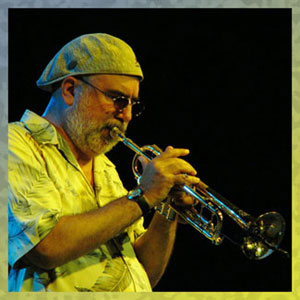 I wanted to have these very punchy and forceful horn stabs on the and-of-2 of the even numbered bars, and so I ended-up with a particularly interesting 5-note voicing, for which I wrote out each note for Randy, and he overdubbed them after having played his original parts. The finished version that you now hear offers the added dimension of Rob Mounsey's trombones giving the blend some extra punch!!! I wanted to have these very punchy and forceful horn stabs on the and-of-2 of the even numbered bars, and so I ended-up with a particularly interesting 5-note voicing, for which I wrote out each note for Randy, and he overdubbed them after having played his original parts. The finished version that you now hear offers the added dimension of Rob Mounsey's trombones giving the blend some extra punch!!!Now we come to the ever problematic bridge section, which for the purposes of my arrangement, it has been labeled as letter [C], and it consists of two rather odd 6-bar phrases, one a half-step above the other. When listening to the original versions, it can seem as though the bridge is at another tempo from the [A] sections, but despite Haden's change to walking bass, I think that they're pretty similar. From there, we play [B2]-[I2]-[A]-[B] and a percussion break of 8 bars before the first solo, Randy's, begins. Once again, what to solo over was a big question. Firstly, in order to separate myself from what Ornette and the great quartet had done, I decided that each solo would have a 24-bar Prelude, letter [D], out in front of it. This section would have a complete change of texture, including Rob's string pads, giving Randy some time to explore a V7(alt.) area of Eb7(#9b5). From there, I decided that we would play over an invented 32-bar [A]-[A2]-[B]-[A3] form which, for the purposes of this chart, became [E]-[E2]-[F]-[E3]. I wanted to create chord changes that were close to the feeling of the tune itself, but also to embrace a certain bluesiness as well. As you view the transcription, you can see what I chose to do. Before I begin discussing what I played on "Latin Genetics," I have to say just how brilliantly I feel that Randy Brecker played on this track. Apart from his fantastic sound and time feel, his fire, creativity, harmonic adventurousness, and swing all served to remind me of wonderful times together from years past. In the end, Randy's solo informed and inspired what I was about to play. It seemed to outline a musical territory that I felt most comfortable falling into. For my Prelude, letter [D2], I changed the chordal sonority to Eb7(9sus). If I was only to approach it from a completely consonant level, I would have been applying tones from Bb Dorian [Bb, C, Db, Eb, F, G, Ab], but, as you will see, I found ways to flirt with other harmonic areas. The chordal passage during the opening 2 bars was inspired by something that Chick Corea played during his solo on "Creek," which appeared on Airto's 1972 CTI album, "FREE." From there, the lines begin to flow, and are, for the most part, within the suggested modal area. You might also want to pay attention to how I used my vibrato on all of the long notes. The contrasts to strictly modal playing appear first in bar 11, there you see a brief A7 arpeggio, the b5 substitute for Eb7, vaulting up to a G-natural and then coming chromatically down to F, both consonant notes. Leading into bar 13, there is a long phrase born of a rhythmic motif, and just as it seems to be moving along in a logical manner, at the end of bar 15 it lands on the non-chordal tone of B-natural. In bar 16, that same B-natural is then surrounded by its chromatic yet consonant upper and lower neighbors, C and Bb. From bars 17-20, again, the b5, A-natural, plays a role in the two lines that span those bars. Notice the F triad in bar 18 that ascends to Ab, a chord tone. Bars 21-24 offer a different linear manner of playing around the root or tonal center. In bar 22, there are aspects that you could say are related to Em7, and E Dorian [E, F#, G, A, B, C#, D]. Then, in bar 23, I descend using an A triad, landing on a lower A-natural(b5) that is held against the rather lush chordal sonority. But that note is clearly outside of the center. But notice how, in bar 24, as I lead into the solo changes over an Ab7 chord, the line heads right towards a resolution on an Eb, the 5th of the new key area. As Chorus 1 begins with a phrasing technique that I constantly talk about at these pages, and that is to finish phrases using long-short articulation. The reason is simple in that, I believe that this is where the sense of 'swing' comes from in your playing, even in an even 8th-note context like "Latin Genetics." You will see this kind of phrasing indicated throughout the transcription. To restate it, the [E] sections were designed to allude to the blues in some way, as you see I7-IV7-V7-I7 during the 8 bars. Over the Ab7 bars, because there is no additional chordal instrument, I am free, at times, to drift between lines that can sound like I am playing in Ab major and, at other times, over Ab7. It just depends upon what I heard and felt at that moment. In bar 3, over the Db7 chord, I am really approaching this from an Ab Dorian [Ab, Bb, Cb, Db, Eb, F, Gb] perspective, the G-natural that you hear in bar 3 is really more of a neighboring tone than any pronouncement of it being the b5 of Db7. So don't make too much of that note! In bar 5, over the Eb7 chord, the line puts to use the chromatic upper(Ab) and lower(F#) neighbors to the 3rd(G-natural). But, the answer to that phrase takes us into Randy territory, as the line comes from using B dominant 7th pentatonic [B(#5), C#/Db(7th), D#/Eb(R), F#/Gb(#9), A(b5]. Notice how this produces 3 of the 4 altered tones over Eb7. 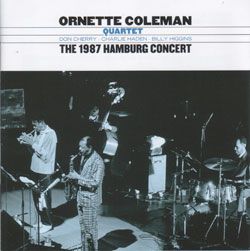 In bar 7, as we are still over Eb7 for a bar, again, the target note of A-natural is also surround by its chromatic upper and lower neighbors, and I play up from the A-natural to E-natural. Over Eb7, if you hear and like these sounds, you can view them as the b5 sub(A7) of Eb7. The last phrase of the section is a simple paraphrase of Ornette's main melody. One of the classic elements in any solo improvisation is to draw upon the melodic material that you have heard and played from before. This gives a solo context and continuity. In bar 7, as we are still over Eb7 for a bar, again, the target note of A-natural is also surround by its chromatic upper and lower neighbors, and I play up from the A-natural to E-natural. Over Eb7, if you hear and like these sounds, you can view them as the b5 sub(A7) of Eb7. The last phrase of the section is a simple paraphrase of Ornette's main melody. One of the classic elements in any solo improvisation is to draw upon the melodic material that you have heard and played from before. This gives a solo context and continuity.[E2] begins with a nice breath. Don't forget to breath!!! And the phrase in bar 2, still over Ab7, puts to use the b5 sub D7 by applying a part of the D dominant 7th pentatonic [D, E, F#, A, C], and that same D-natural(b5) plays a role in the phrase over Db7 in bars 3-4. The difference over that chord is the D-natural becomes the b9. All of this cerebral analyzing does not mean anything if you do not hear things this way. That remains the prime element, no matter what it might be, you have to play things that you hear, and that you believe in yourself! In bars 5-6, over Eb7, the phrase begins by putting to use chromatic fragments drawn from Bb Dorian [Bb, C, Db, Eb, F, G, Ab], but in bar 6, the line transitions into a blues-based phrase using A7, again, the b5 sub for Eb7. The last note of the phrase, C-natural, is a consonant note in the proper mode. The section concludes in bars 7-8 with the V7-I, by using a common Jazz linear device of descending via the b9(Fb) and through Eb-Db to a very simple Ab major triad. Notice the long-short phrasing at the end of the bar. Whether it's Jazz or James Brown, going to the IV7 chord ("Take it to the bridge!!!") is a classic device, and when I put together this format and these changes for soloing, this seemed like the right way to go. So, the [F] sections all play this way: | Bb7 / / / | / / / / | Eb7 / / / | [Em7 / A7 / ]|| Bar 1 of the section offers the first chordal punctuation that we've heard during this solo. Inside these simple 3-note voicings you heard the upward movement of a 4th from a basic Db6/9 voicing to Cb/Db. That simple Cb triad [Gb(sus4), Cb(7th, Eb(9th)] provides us with beautiful color tones. The configuration of the single-note line in bar 2 is something that I used to hear both Randy & Michael Brecker play all the time. You have the simple chromatic descending movement of Db-C-Cb, the root to the b7, but it is the insertion of the Ab before the C-natural that gives this little phrase much more character and, for a moment, alludes to the V chord, of Ab. In bars 3-4, the line is completely consonant, and comes from Eb Dorian [Eb, F, Gb, Ab, Bb, C, Db]. Over the Bb7 chord, the V7 of V7, you see that the key note of F-natural(5th) is surrounded by both of chromatic upper(Gb) and lower(E-natural) neighbors before descending to the 3rd(D) of the chord. Then, leading into the Eb7 chord for bars 7-8, the descending line passes through the chromatic upper(B) and lower(A) neighbors to Bb(5th) as the line in bar 7 is all Bb Dorian. But then, for a moment, the phrase in the 1st half of bar 8 is derived from E Dorian before cadencing to Eb-Ab. Once more, long-short!!! [E3] begins with the 1st appearance on "BACKLOG" of my own personal Psychedelic Big Band, courtesy of my Korg DVP-1 Harmonizer. Joe Zawinul's former keyboard tech, Ralph Skelton, helped me out greatly by rigging-up an on/off switch that enables me to use the DVP-1 whenever the moment seems right. The reason that I needed Ralph's help so badly was that, for some reason, the Korg designers did not give the user, the player, the option of being able to cue the effect in & out, or have your sound go through the chain clean. Not having a bypass switch is certainly an annoying omission. So Ralph, with his immense electronic problem-solving skills, designed a way to route my signal so that I could finally have the kind of control that I needed. I'm so grateful for his help. On the device itself, I can store up to 5 banks of sonorities, each with 8 programmed options. This gives me a wide harmonic palette from which to choose. I have these banks programmed in groupings so that each bank represents one of the principal chord families. To have these options, and to be able to employ them spontaneously, has been a great luxury for me. Normally, I position the DVP-1 to my immediate right, sitting in its black rack bag, and on top of my blue road case, so that I can take a breath, and reach out with my right hand, and then change the sonority within the bank that I've chosen. As this final section of the 1st chorus of the solo begins, I used, what I have labeled as Sound #12. This is, in essence, a dominant 7th chord, and the note that I am actually playing becomes the 3rd of that voicing. When using this device, the trick is to always program the harmonized notes BELOW the one that you are playing. So in this case, the top voice is harmonized below by a major 3rd [-4], a b5 [-6], and a maj6th [-9]. This sonority is one of my favorites to use over dominant 7th chords, because it does have a quirky but sophisticated blues-related feeling to it. All the notes that I played are very consonant except for the one Cb, a chromatic upper neighbor, to the more consonant Bb, the 5th of Eb7. Notice how many solid quarter-notes I played in this section. Though I certainly wasn't thinking about it at the time, this could have been inspired by the immense half-note pulse coming from Rubén Rodríguez' electric bass and drummer Mark Walker's stomping bass drum. I absolutely love how both of them played on "Latin Genetics" as they injected tremendous spirit and feeling into everything! Chorus 2 begins with an 8 bar section that is unified by a particular rhythmic grouping that embraces several different pentatonic forms. In bar 1, over the Ab chord, you have F minor pentatonic [F, Ab, Bb, C, Eb], which can be considered blues related, even though it contains no 7th degree. That is followed by, in bar 2, a fragment that is really just a 1/2-step above, and could be labeled as either Gb/F# minor pentatonic [F#, A, B, C#, Eb]. What is crucial here is that, if you do not hear things this way then don't play such things, because it will never sound believable! Over the Db7 chord, the line really comes from Ab minor pentatonic [Ab, Cb, Db, Eb, Gb] and this gives a greater sense of a suspended feeling which I like very much, because you do not hear a 3rd of any kind anywhere. From there, bars 5-8 are all very consonant, and this demonstrates a balance between lines that create tension, and then, that same tension is resolved in a musical way. 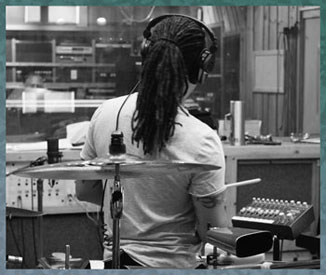 If you only have all dissonance that can be just as boring as having only consonant tones. Though it was hardly by design, the last phrase that goes right up an Ab triad, 2nd inversion, and lands it on the root above, has become a thematic device throughout this solo. Randy had a similar cadence during his solo. So perhaps, subconsciously, this is where this might have come from. If you only have all dissonance that can be just as boring as having only consonant tones. Though it was hardly by design, the last phrase that goes right up an Ab triad, 2nd inversion, and lands it on the root above, has become a thematic device throughout this solo. Randy had a similar cadence during his solo. So perhaps, subconsciously, this is where this might have come from.As [E2] begins, we hear the return of the DVP-1, this time using Sound #18, which, below the note that I am playing, gives you: a major 2nd [-2], a perfect 4th [-5], and a b7 [-10]. In the first 2 bars, I hear that simple phrase sitting hard on the quarter notes as being from the Ab blues scale [Ab, Cb, Db, D, Eb, Gb], though you don't hear all the blue notes. This is where the lines blur between the blues scale and the minor pentatonic. The 2nd half of the phrase in bar 3 is made more interesting because the Ab is approached from a 1/2-step above, A-natural, which is not in the tonality, and is not a blue note either. Then, there's a nice breath taken in bar 4. Bars 5-8 of the section reflect another guitar approach that I enjoy experimenting with, often during practice and preparation time before actually recording, and that is to see if I can uncover any interesting chordal formation that puts to use an open string or two. So, in bars 5-6 you hear me using a rather standard 7#9 or 13b9 kind of voicing in Eb7, but adding in the open E-string(b9) to both forms. Bar 7 follows with a most traditional Jazz line when V7(alt.) is going to I7. Fundamentally, I am using the Eb altered dominant scale [Eb, E, Gb, G, A, B, Db]. but many players like to think of it as E melodic minor [E, F#, G, A, B, C#, D#]. As you can see, they have exactly the same notes, though enharmonically spelled. As the line cadences to Ab7 in bar 8, it can't be more simple than going from a low Eb up a 6th to C-natural. Again, always phrased long-short!!! As we arrive at letter [F] for this chorus, the focus turns completely to a chordal approach. For bars 1-2 of the section, I am simply putting to use major triads, both Cb and Db, over the Db7 chord, and playing them in a montuno style. Over the Ab7 chord in bars 3-4, these piano left-hand voicings owe so much to McCoy Tyner, and Chick Corea's playing on Cal Tjader's 1966 Latin Jazz classic, "SOUL BURST." I owe a lot to him, and all that I gleaned from listening to that album during my college years and beyond. In bars 5-6, to create a spacey effect, I played a voicing spelling up: Ab-C-E-G-C over Bb7, which creates the sonority of Bb7(13b5). To enhance that moment, I added in, via overdub, my Strat with a volume pedal and the tremolo arm playing something similar. This too provides a nice breath from all the activity. Finally, in bars 7-8 over the Eb7 chord, I am playing voicings that have a 9sus feeling to them which I liked very much, and again, to me, in this context, it is all from the Tyner-Corea approach. The long-short punctuations in bar 8 offer an Eb7(13b5b9) sonority to create a cadence to lead us back to Ab. Bars 1-2 of [E3] begin with another paraphrase from Ornette's wonderful "Latin Genetics" melody. Then, in bar 3, over Db7, the line briefly darts away from the tonality with three notes that, if spelled differently, might reveal Gb minor over the Db7: A(Bbb)-E(Fb)-F#(Gb). The answer to this 3-note fragment is really rooted in the Db blues language, as you see Fb, Cb to Db. In bars 5-6 over the Eb7 chord, the line still offers notes from Bb Dorian, as previously mentioned. In bar 7, as that Eb7 chord is extended, the line, which passes through a G major triad(G-D-B), is comprised of V7 chords, but one 1/2-step above where this one appears. One of the things that I have always loved about Randy Brecker's playing is that he has used the maj7#5 formation both chordally and linearly as a V(alt.) chord, even though it has the maj7th in it - and most people would consider that to be a 'bad' note over a dominant 7th chord. But, in a context like this, where there is only the soloist's moving line and Rubén's bass line, how you move your lines and chords around is totally up to YOU! It just depends on how far left or right of center you have come to hear things. The other piece of harmonic logic and reason here is that, the G triad is only 1/2-step below where you are headed, that being to Ab. And, lo and behold, in bar 8, once again, I ascend up that same Ab major triad. In Chorus 3, the 1st 8 bars owe everything to some of what Randy played during his fantastic solo, especially in his 2nd chorus. Bars 1-2 offer very simple chord tones in Ab, but played in sharp rhythms that flow with the clave. But then, in bars 3-4, as the chord change to Db7 arrives, the line ascends up a Gb triad, and comes back down using a G triad, which is the b5 sub. To repeat, if one is comfortable with these sounds, nothing is going to sound out of place or strange. If you are trying to force it in there for any reason, it is not going to sound good! In bars 5-6, over the Eb7 chord, the line descends using a simple Eb augmented triad, but instead of landing on an Eb, I end-up using Randy's Ebmaj7#5 sound, and there is a D-natural. But finally, in bar 7, I played straight down Eb augmented: B-G-Eb-B with the B-natural ending up pulling to C-natural, and right up that same Ab major triad. At [E2], from bars 1-4 there is a return to chords. One of the most wonderful parts of McCoy Tyner's playing is when he slams down a 5th with his left hand, and then that is followed by some intense chordal passages. Depending upon the key, on the surface, this does not seem like it would be too difficult to replicate on the guitar. But, in my experience, it is hard to achieve that same emotional effect and power. That stated, what I played in bar 1, what we guitarists might describe as a power chord formation, considering the guitar tone that I am playing with, this sounded really good to me. The chords that follow, even though the top voice is a note within the Ab7 tonality: Bb-C, C#(Db). Those top notes are all harmonized below by one parallel m7sus voicing. This is also very characteristic of the Tyner style. Then, over the Db7, I am using those same Cb and Db triads, but with strong, decisive rhythms. 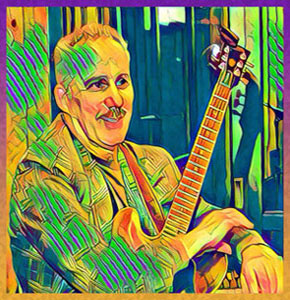 Over the Eb7 chord, between bars 5-7, the notes are all consonant, and they are played using a typical string-skipping technique that I like to use, along with many of my generational guitar brothers!!! In bar 8, it all resolves to that ascending thematic Ab major triad. Over the Eb7 chord, between bars 5-7, the notes are all consonant, and they are played using a typical string-skipping technique that I like to use, along with many of my generational guitar brothers!!! In bar 8, it all resolves to that ascending thematic Ab major triad.If you're new to the website and these pages, I want to share the story behind the DVP-1 sound that I used for letter [F] of Chorus 3, if you will allow me. Whenever I am fortunate enough to work with Randy Brecker, it is difficult not to have brother Michael in my thoughts. And so, as I was preparing to record, practicing, playing along with the demos that I had created, I thought to myself that it might be really great if, in an unspoken tribute to Michael Brecker, I could somehow extract one of his unique EWI sonorities, and program it into my own DVP-1. But HOW was I going to do that when all those voicings seem to fly by so fast? As I have mentioned before, I am never shy, when needing some help to hear something more clearly, about turning to Andy Robinson's brilliant program called "Transcribe!" which, years ago, Michael recommended to me. So now, armed with this super-duper tool, I decided to explore some of the incredible EWI passages from "Itsbynne Reel," which appeared on his "DON'T TRY THIS AT HOME"(¡mpulse!). During this scientific exploration, I discovered that many of the sonorities were sounds I had already programmed, but, there was one particular voicing, which appears only briefly, that I had never thought of until I was able to isolate it. I loved it so much that it has become Sound #48, which puts it in the same bank of sounds, and makes it possible to play live while soloing. In this case, the top voice is harmonized below by a minor 3rd [-3], a perfect 4th [-5], a perfect 5th [-7], and finally, the lower octave [-12]. So what you hear in bars 1-2 and 5-6 of this [F] section is, in its way, quietly dedicated to Mike. Of course, to really be able to use the harmonizer effectively, you have to play those passages in your upper register, usually not going any lower than a note on your G-string, as that can be too low. Repeating myself, the key to making this work well is that, the note I am playing is the principal note that you hear, and the harmonization is all below that note. So, over that Db7 chord, with the top notes of the phrase ascending: Db-D-E-F-Db, they all come from the Db altered dominant scale [Db, D, E, F, G, A, Cb]. There are those who would view this as D melodic minor [D, E, F, G, A, B, C#], but the notes are the same, it just depends upon your point of orientation. Over the Ab7 chord, the single-note line becomes much more consonant, and is from F minor pentatonic. With the arrival of the Bb7 chord in bars 5-6, the DVP-1 sounds return, and the top notes are derived from a traditionally chromatic blues-based phrase that starts on the root and returns to it. Over bars 7-8, Eb7, the first bar spells out that very chord, but in bar 8, as we are about to cadence to Ab and the last 8 bars of the solo form, you see an A7 chord spelled-out, this being the b5 sub of Eb7, and it resolves to a C-natural as we head into the last section. The first 4 bars of [E3] see the last appearance of the DVP-1 during this solo, and we jump to Sound #36 with my top voice being harmonized below by a minor 3rd [-3], a perfect 4th [-5], a minor 6th [-8], the subtle change of the lowest note gives these lines a different character. The top notes of the lines really come from a particular kind of blues phrasing where, in addition to the expected blue notes, you also have an F-natural(6th), which gives the lines a different flavor. I remember as a kid hearing Mike Bloomfield play things like this. As the solo closes out in bar 5-8, I turn to a familiar chordal configuration of Eb7(#9) that adds in the open E-string(b9), and gives some extra character to the sonority. The final line, played in chords, ascends from E-F-F#-G, all parallel with the same 7(13b9) voicing in Eb, and finally cadencing to a very common Ab7(13) voicing, spelling-up: Gb-C-F-Ab. After the solo, we move right into the Soli section, which is an ensemble passage of 28 bars, including a 2-bar percussion break at the end, that is performed by Randy, Rubén and me. As I have done in the past, I transcribed some of my favorite phrases from Ornette Coleman's original solo, and then rearranged them into a form that made musical sense to me, and also could be in clave.  The accented figures that I indicated on the charts were executed with strength and grace by Marc Quiñones on timbal, and mostly Mark Walker's bass drum. Sometimes a section like this can get too heavy-handed if everyone is making all the hits with all the drums possible. I remember many, many years ago, when I was a little kid and my father took me to Las Vegas, we went to see Bobby Darin, and his musical director and conductor was the great Roger Kellaway. I have never forgotten the arrangement that they played of, of all things, "Mack the Knife," and Roger had Bobby singing the first chorus or two alone with nothing but the bass and the bass drum (later joined by some light brass punches), and it was really a striking idea. So, from that time forward, I have always known that you can do something like this, and just cover the hits with the bass drum, and not much more. So, the concept, derived from an odd source and experience, brings back lots of memories. The accented figures that I indicated on the charts were executed with strength and grace by Marc Quiñones on timbal, and mostly Mark Walker's bass drum. Sometimes a section like this can get too heavy-handed if everyone is making all the hits with all the drums possible. I remember many, many years ago, when I was a little kid and my father took me to Las Vegas, we went to see Bobby Darin, and his musical director and conductor was the great Roger Kellaway. I have never forgotten the arrangement that they played of, of all things, "Mack the Knife," and Roger had Bobby singing the first chorus or two alone with nothing but the bass and the bass drum (later joined by some light brass punches), and it was really a striking idea. So, from that time forward, I have always known that you can do something like this, and just cover the hits with the bass drum, and not much more. So, the concept, derived from an odd source and experience, brings back lots of memories.I have to say that the performances on this tune by both Marc and Bobby Allende(conga) are just spectacular! Bobby added so much to everything, and the spirit with which he approached the conga throughout really helped to take the piece to a new level, which I appreciated so much, considering all the struggles just to be able to finally play one plena on a recording of mine. So this was a big thrill for me!!! Interlocked with everything was Marc's addition of the güira, which is the one extra percussive color necessary for this Puerto Rican rhythm. If you're searching for it in the mix, you can hear it on the right side throughout. When I had constructed all 10 of the demos for the recording and began listening to them, living with them, and imagining what the finished recording might sound and feel like, I was really certain, based upon my repeated listenings, that I had a sequence in mind that I thought was great. And, believe it or not, I was certain that "Latin Genetics" would open the album. Throughout the process, I held onto that thought. But, as it always is, one has to listen to the learned voices that surround them during any creative project. How well I remember two separate exchanges with Rob Mounsey and engineer James Farber. During our digital editing days, when hearing about my ideas for the sequence, and "Latin Genetics" appearing first, Rob said to me, most succinctly, "I don't know about that, it's just too happy!!!" No sooner had he said that, and I just knew that he was right! And so, I began to re-think my original idea, and, after much thought, somehow, "Latin Genetics" slid down to its eventual slot at Trk. [3], preceded by "Criss Cross" and then "Concepticus in C." As we have now arrived at March, 2017, and the weather in the northeast is beginning to warm-up a bit, but our political climate in Washington, DC, becomes more insane with every passing day. Like everyone else who cares deeply about our country, I have no idea where this is all headed, where things are going to end up, but also like a certain segment of the population, I have felt embarrassed and ashamed of the comportment of our president. We'll see where this all goes. In the meantime, here's wishing all those who visit these pages a very happy springtime!!!
[Photos: Randy Brecker
Marc Quiñones' Hair - Photo by: Adela Blanco @ Avatar Studios, April, 2016 Steve Khan - Photo by: Richard Laird with Prisma® Treatment by: Adela Blanco] |